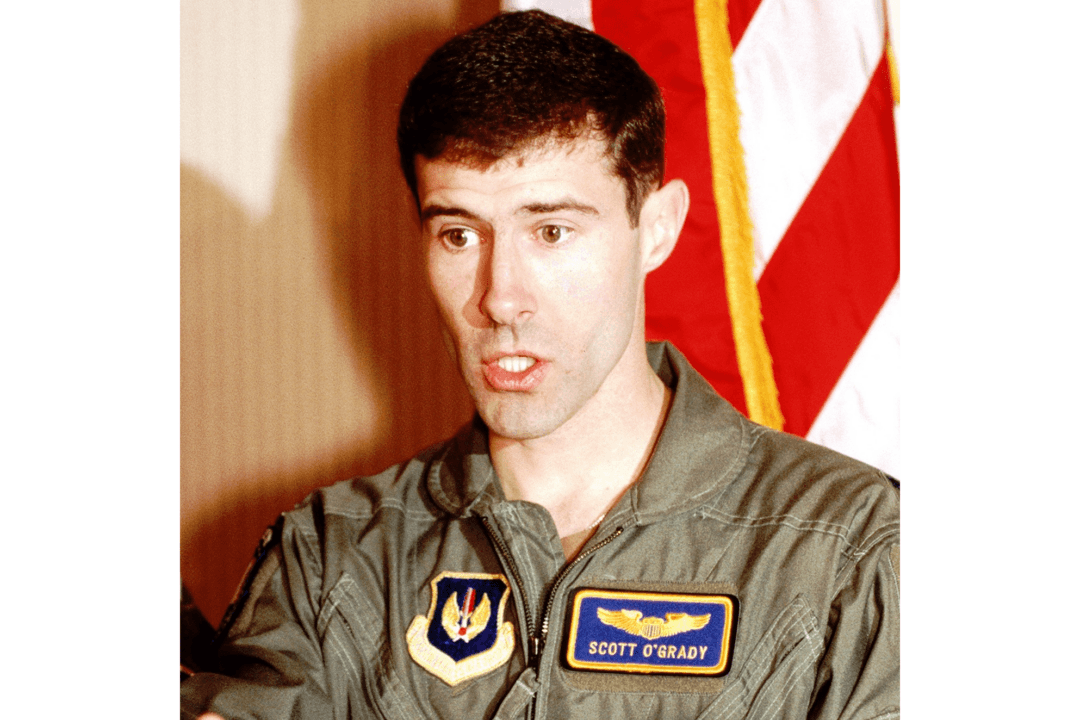On Oct. 18, 1990, a report conducted by the United States’s intelligence community was issued predicting the breakup of the Federal Republic of Yugoslavia and its inevitable violent aftermath.
It was a prescient warning. With hundreds of thousands killed and millions displaced, the former state of Yugoslavia became the site of Europe’s most violent conflict since the end of World War II. As the democratic world rejoiced over the fall of the Berlin Wall in November 1989 and the resulting reunification of Germany, the dismantling of communism, and the end of the Cold War, there seemed little to celebrate in the Balkan region.
Yugoslavia rapidly disintegrated as Slovenia, Croatia, and Macedonia declared independence in 1991, followed by Bosnia and Herzegovina in 1992. Serbia and Montenegro combined to form a new Federal Republic of Yugoslavia in 1992. Violence was rampant throughout the region, but nowhere more so than Bosnia and Herzegovina, where Bosnian Serbs maneuvered to create a “Greater Serbia.”
Embroiled in bitter ethnic clashes, the Bosnian War began with Bosnia and Herzegovina’s April 1992 independence declaration until the end of 1995. Approximately 100,000 Bosnian Serbs, Bosnian Croats, and Bosnian Muslims, known as Bosniaks, were killed—a vast majority of whom were the latter.

NATO and the US Air Force
Throughout the war, NATO forces, led primarily by American air power, worked to deter the conflict. The air forces of the United States and its national allies flew nearly 110,000 sorties across Bosnia and Herzegovina in an effort to deliver aid to Bosnians, enforce a naval embargo, and establish a no-fly zone as part of NATO’s Operation Deny Flight from April 12, 1993 to Dec. 20, 1995. Although NATO air forces had shot down four Serbian bombers, these operations were only partly successful as they did not result in bringing the war to an end.A Bad Time to Fly
In the early afternoon hours of June 2, 1995, Capt. Scott O’Grady, of the U.S. Air Force’s 555th Fighter Squadron, prepared to conduct a routine flyover as part of Operation Deny Flight. The 29-year-old fighter pilot, along with lead pilot 33-year-old Capt. Robert Wright, climbed into each of their F-16 Fighting Falcons at Aviano Air Base in Italy. It had been 10 days since his last mission, and he wasn’t scheduled to fly this day. But when O’Grady was informed of the opening in the flight schedule, he took it. At 1:15 p.m., O’Grady, call sign Basher Five-Two, was in the air heading over the Adriatic and into hostile territory.The civil war in Bosnia-Herzegovina had worsened heading into the summer months. Not only had the factional conflict on the ground increased, but those groups, especially the Bosnian Serbs, had become increasingly hostile to NATO forces. After NATO forces conducted limited airstrikes in May, the Bosnian Serbs took approximately 400 United Nations peacekeepers hostage, using them as human shields. In July, Serbian forces attacked a U.N. safe haven in Srebrenica, massacring approximately 8,000 Muslims. Dead middle between these two events was Wright and O’Grady’s flight.
Enemy in Place

“Basher Five-One, mud six, bearing zero-nine-zero,” Wright called out to O’Grady. Wright’s radar had picked up a possible threat east of their position. But just as soon as it had arrived, it was gone. The pilots were aware that if the threat was real it was most likely a surface-to-air missile (SAM). Fortunately for the pilots, their F-16s were capable of immediate radar detection. Of course, this required the enemy to have their radar on as well.
Thousands of feet below the American pilots, Bosnian Serb soldiers were moving their SA-6 into position. They had been able to track the F-16’s flight pattern with relative ease. Having located the F-16s and with their predictable pattern, the enemy moved into place, aiming their SAMs at the soon-to-be passing jets. They would not have to use their radar until after firing, and once the missiles were in the air, nearing the jets, the radar would be turned on and the missiles would lock onto their target.
Basher Five-Two Down

The first missile exploded near O’Grady, missing him, but the second 3M9 made a direct hit, splitting the F-16 in half and turning it into a ball of fire. O’Grady’s fiery capsule fell into thick clouds, inhibiting Wright’s vision. He couldn’t see if O’Grady had ejected in time.
For O’Grady, two seemingly impossible things had happened in an instant: His F-16 had taken a direct hit, and he had survived the blast. He was now floating toward the war-stricken countryside of Bosnia and Herzegovina.
If there was a saving grace in his unfortunate landing, it was that the area was heavily forested and possessed caves. The moment his boots hit the ground, he shed his parachute and fled. It was imperative he move quickly. He had landed between Banja Luka and Bihac, two Bosnian Serb strongholds, and the locals had witnessed the explosion and watched the captain float to Earth.
Survival Instincts
When night fell, he slowly moved. Using the two-way radio connected to his survival vest, he tried to make contact with NATO forces. There was only static. He had to use the radio sparingly to preserve battery life. This problem was made worse due to the fact that in his haste, he left his backup radio. He also left behind half his water rations. Not knowing how long he would be stuck behind enemy lines, he conserved his water as much as possible and prayed for rain.Along with his radio and water packets, O’Grady carried a Swiss Army knife, a 9 mm Beretta, a GPS receiver, an evasion map, and a printed note (in 11 languages) stating that the U.S. government would pay whoever hid their airman from the enemy. The most important asset O’Grady brought on this unexpected trip was his training. He had gone through the mandatory 19-day Survival, Evasion, Resistance, and Escape (SERE) training at Fairchild Air Force Base in Washington.
He had been trained to prepare for the psychological and physical stress of such a situation. He had also been shown how to test if a plant was edible or not. Leaves and plants, along with ants, would supplement his diet. After three days, he ran out of water. Thankfully, even in June, Bosnia and Herzegovina experiences consistent rain, and on the fourth night it rained. He collected as much rainwater as possible in ziplock bags. During the daytime, he remained in hiding, only moving slowly and noiselessly when night fell.
Contact and Rescue

The pilot, by means of no movement during daylight hours, slow and methodical movement at night, and, in an effort to maintain strength and body moisture, had moved no more than two miles from his original crash position. But O’Grady had a spot in mind that he needed to reach. He found a hilltop that he believed would enable him to make radio contact.
In the dark of night, atop the hill, O’Grady again tried his radio. Zooming through the sky at the same time was Capt. Thomas Hanford, who was calling over the radio for Basher Five-Two. Hanford’s call came through. It was 30 years ago during this week in history, on June 8, 1995, at 2:08 a.m. that O’Grady made contact: “Basher Five-Two reads you. I’m alive. Help!” To ensure it wasn’t a Serb trick, Hanford had O’Grady make a trivia confirmation. O’Grady confirmed.
Hanford relayed the information. Off the coast of Bosnia and Herzegovina in the Adriatic sat the helicopter carrier Kearsarge, the flagship of Amphibious Squadron Eight. Aboard the Kearsarge was the 24th Marine Expeditionary Unit (MEU) led by then-Col. Martin Berndt. The Special Operations Capable (SOC) MEU had been standing by almost from the moment O’Grady’s F-16 went down. Adm. Leighton Smith, NATO’s commander in chief for Allied Forces Southern Europe and commander in chief of U.S. Naval Forces Europe, called Berndt, “Get the force ready to launch.”
Forty armed and camo-painted Marines, led by Berndt, piled into two CH-53 Super Stallion helicopters. They were joined by two AH-1W SuperCobra helicopters, two AV-8B Harrier jets, two EA-6B Prowlers, two F/A-18D Hornets, two A-10 Warthogs, and F-16s. Altogether there were 40 aircraft involved. At 5 a.m., the MEU Tactical Recovery of Aircraft and Personnel (TRAP) mission was on its way. It took 50 minutes for the helicopters to reach O’Grady’s position.
Yellow smoke from O’Grady’s flare marked his position. The first Stallion landed and 20 Marines leaped out to secure the area. Before the Marines from the second Stallion could get out, O’Grady was sprinting to the landed Marines, pistol in hand. He was quickly disarmed and maneuvered into the helicopter. In a matter of minutes, the Super Stallions were in the air zooming back to the Kearsarge at 175 mph.
The Marines and O’Grady were not in the clear yet. The paramilitary groups had been monitoring radio communications. Suddenly, ground forces opened up on the helicopters with small arms fire, including shoulder-fired SA-7 missiles. The Stallions rocked back and forth violently to avoid the missiles and the gunfire.
At 12:49 a.m. EST, the phone rang at the White House. President Clinton picked up the phone. It was Anthony Lake. His message was succinct: “Got ‘im.”
O’Grady’s six days behind enemy lines in war-torn Bosnia and Herzegovina were over.







